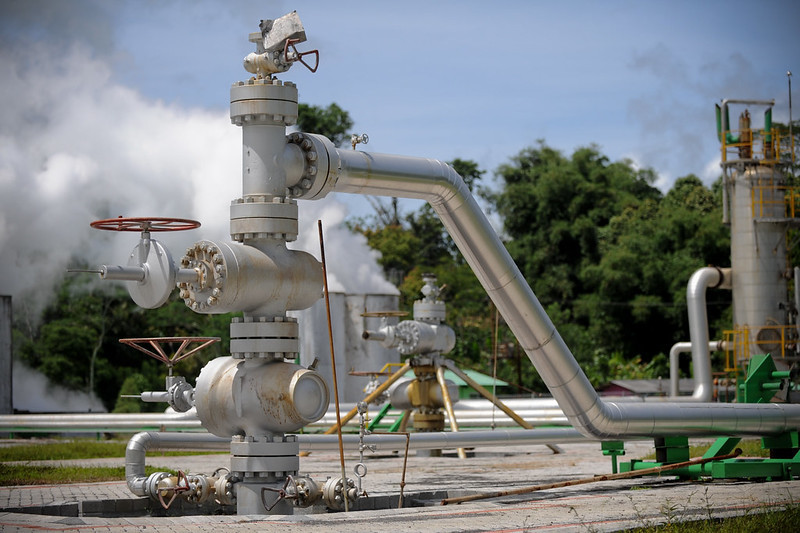12 Desember 2023 4 menit
Revisi taksonomi hijau menyebabkan ‘ketidakpastian’ transisi energi: Kritikus

Para ahli mengatakan rencana revisi taksonomi hijau yang ditetapkan pemerintah menyebabkan ketidakpastian dalam transisi energi di Indonesia karena tidak memasukkan kategori “merah” dan beralih dari sistem kategorisasi lampu lalu lintas ke dikotomi “hijau” dan “transisi”. Agung Budiono, direktur eksekutif organisasi nirlaba Indonesia Cerah, menjelaskan bahwa rancangan Taksonomi Berkelanjutan Indonesia (TBI) memperkenalkan label “tidak memenuhi syarat” untuk kegiatan usaha yang dianggap berisiko. “Tetapi tidak ada penjelasan [tentang label itu] yang dimasukkan dalam rancangan tersebut,” katanya pada hari Kamis di sebuah acara yang diselenggarakan oleh ResponsiBank Indonesia, membandingkan rancangan taksonomi hijau Indonesia yang direvisi dengan Taksonomi Hijau Singapura, yang memberikan kriteria rinci untuk mendefinisikan risiko tinggi. aktivitas bisnis di bawah label yang tidak memenuhi syarat. “Kami menyarankan agar Otoritas Jasa Keuangan [OJK] memperjelas [kegiatan] mana yang dianggap tidak memenuhi syarat. Kalau kategori “hijau” dan “transisi” saja, itu [menimbulkan kesan] bahwa OJK bermain aman,” tambah Agung.
Perwakilan OJK menolak berkomentar mengenai hal tersebut. Revisi tersebut akan dilakukan secara bertahap, dan mulai tahun 2023 OJK akan menyusun kriteria teknis sektor energi. Badan ini telah mulai berupaya merevisi Taksonomi Hijau Indonesia (THI) Versi 1.0 untuk beradaptasi dengan perubahan yang dilakukan pada Taksonomi ASEAN untuk Keuangan Berkelanjutan (ATSF) pada bulan Juni, yang berfokus pada mendorong aliran modal dan investasi untuk transisi energi di Asia Tenggara. Draf tersebut dirilis pada 13 November dan terbuka untuk konsultasi publik hingga Jumat pekan lalu.
Linda Rosalina, direktur eksekutif kelompok advokasi iklim Transformasi Untuk Keadilan Indonesia (TuK), mengatakan tidak adanya kategori “merah” membuat sulit untuk menandai aktivitas bisnis yang memiliki konsekuensi berbahaya bagi lingkungan. “Dokumen taksonomi hijau yang direvisi harus memperbaiki keadaan, bukan meningkatkan ketidakpastian atas upaya transisi energi di Indonesia,” katanya pada hari Kamis, seraya menambahkan bahwa taksonomi tersebut harus diwajibkan bagi para pelaku sektor keuangan untuk secara efektif mengurangi emisi dan mendorong lebih banyak pembiayaan untuk energi berkelanjutan dan energi. proyek energi terbarukan. Linda melanjutkan, agar OJK mengatur pembatasan pembiayaan berdasarkan label yang ada dalam taksonomi, hal ini dapat dilakukan dengan memberikan insentif dan disinsentif dalam penerapan taksonomi tersebut. Proyek yang berlabel “kuning” dan “merah” menerima pendanaan lebih besar dibandingkan proyek berlabel hijau pada paruh pertama tahun 2022, menurut laporan yang diterbitkan OJK. Dalam laporan tersebut, OJK mengidentifikasi pembiayaan sebesar Rp 1.065 triliun hingga Juni 2022. Bagian terbesarnya, sekitar Rp 392,87 triliun, disalurkan ke proyek-proyek berlabel “kuning”. Proyek berlabel “merah” dan “hijau” memperoleh pembiayaan masing-masing sebesar Rp 378,16 triliun dan Rp 294,2 triliun. Dari ketiga kategori tersebut, rasio kredit bermasalah (NPL) paling rendah terjadi pada proyek berlabel “hijau” sebesar 0,81 persen, sedangkan proyek berlabel “merah” mencapai 2,56 persen dan proyek berlabel “kuning” sebesar 4,37 persen, menurut Linda. Nilai rasio NPL yang lebih rendah menunjukkan risiko bank yang lebih rendah. OJK merupakan lembaga pemerintah yang bertugas memproduksi THI bekerja sama dengan beberapa kementerian, antara lain Kementerian Lingkungan Hidup dan Kehutanan serta Kementerian Energi dan Sumber Daya Mineral. Dalam prosesnya, pihaknya juga menerima masukan dari Bank Indonesia dan Badan Kebijakan Fiskal (BKF) Kementerian Keuangan. Proyek penambangan di TBI Muhammad Aulia, peneliti keuangan ramah lingkungan di Action for Ecology and People’s Emancipation (AEER), mengatakan ia merasa bermasalah jika beberapa aktivitas pertambangan dimasukkan dalam label “hijau” dan “transisi” TBI karena perannya dalam membangun teknologi energi bersih. “Tetapi kita harus jelas mengenai kapan kegiatan-kegiatan ini dianggap memiliki peran penting dalam transisi energi. Jangka waktunya harus jelas,” ujarnya, juga, Kamis. Mineral penting seperti tembaga, litium, nikel, kobalt, dan unsur tanah jarang, merupakan komponen penting dalam teknologi energi bersih yang berkembang pesat saat ini, mulai dari turbin angin hingga kendaraan listrik (EV). Namun demikian, menurut Badan Energi Internasional (IEA), mengatasi dampak lingkungan dan sosial dari pengembangan mineral akan menjadi hal yang sangat penting, termasuk emisi yang terkait dengan penambangan dan pengolahan, risiko dari pengelolaan limbah dan air yang tidak memadai, serta dampak dari keselamatan pekerja yang tidak memadai, hak asasi manusia. pelanggaran dan korupsi. Indonesia, yang memiliki cadangan nikel terbesar di dunia, sedang berjuang untuk meningkatkan standar lingkungan untuk penambangan nikel di tengah kekhawatiran atas produksi logam tersebut, yang semakin banyak digunakan dalam baterai kendaraan listrik. Penambangan dan peleburan nikel telah menjadi bagian utama perekonomian Indonesia, dengan investasi global bernilai miliaran dolar mengalir ke negara ini setelah pemerintah melarang ekspor bijih yang belum diolah pada tahun 2020.
This article was published in thejakartapost.com with the title “Revisi taksonomi hijau menyebabkan ‘ketidakpastian’ transisi energi: Kritikus”. Click to read: https://www.thejakartapost.com/business/2023/12/11/green-taxonomy-revision-causes-uncertainty-for-energy-transition-critics.html.
This post is also available in: English
